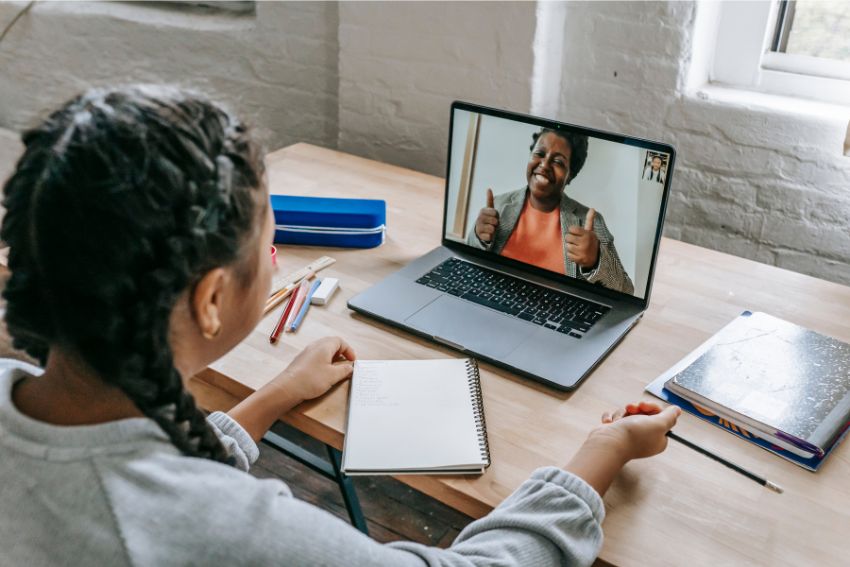When it comes to finding the right educational support, today’s students and parents face a choice that didn’t exist a generation ago: should you go for traditional in-person tutoring or embrace the digital alternative? The online vs. in-person tutoring decision has become increasingly complex as technology advances and learning approaches evolve.
Whether you’re a parent seeking support for your child, a college student struggling with complex material, understanding the full spectrum of tutoring options available today will empower you to make a choice that truly fits your educational needs. Let’s dive into what matters most when deciding between online vs. in-person tutoring.
- How Online vs. In-Person Tutoring Has Transformed Education?
- Exploring Your Options: Online vs. In-Person Tutoring Explained
- The Real Cost of Learning: Online vs. In-Person Tutoring Compared
- Technology's Role in the Learning Process
- Connection Matters: Student Relationships in Online vs. In-Person Tutoring
- Which Suits Your Child Best? Tailoring Online vs. In-Person Tutoring
- How Effective Is Online Tutoring?
- Online vs. In-Person Tutoring: Finding the Right Tutor
- Risks Associated with Online vs. In-Person Tutoring
- The Future of Personalised Learning
- Conclusion
How Online vs. In-Person Tutoring Has Transformed Education?
Tutoring has changed dramatically in recent years. Finding help once meant asking around locally. Now, students can connect with experts anywhere in the world with just a few clicks. The shift to digital wasn’t just about technology getting better, though that certainly helped. It was about breaking down barriers.
Then Covid hit, and everything changed overnight. Parents who’d never considered online tutoring suddenly became experts in Zoom settings and digital whiteboards. You know what surprised many of us? Some kids actually did better online.
The reality is that neither online nor in-person tutoring wins outright. What matters is finding the approach that fits your specific situation, learning style, and practical needs. And sometimes, like many families discovered during the pandemic, the perfect solution might be one you hadn’t even considered before.

Exploring Your Options: Online vs. In-Person Tutoring Explained
Online tutoring happens through platforms like Zoom or specialised websites. In-person tutoring feels different. Online sessions tend to be more structured and focused. In-person allows for more spontaneous moments and physical demonstrations.
An online tutor might share flashcards on screen and use chat for new vocabulary. Meanwhile, an in-person session involves conversation practice across the table with immediate pronunciation corrections. Both work well, just in different ways for different learners.
When it comes to tutor availability, online tutoring offers far greater flexibility. You can connect with subject specialists and even Oxbridge graduates, no matter where you live. In contrast, in-person tutoring depends on who’s available nearby, which can limit your options, especially in smaller towns or rural areas.
The Real Cost of Learning: Online vs. In-Person Tutoring Compared
When choosing a tutor for your child, understanding the cost differences between subjects and education levels is essential. Looking at basic rates, online tutoring typically runs £15-£40 per hour while in-person sessions in most UK areas cost £30-£60. But these figures only scratch the surface of the real costs.
For in-person tutoring, the hidden expenses add up quickly. Parents often spend significant money on petrol driving to tutors in neighbouring towns. Online tutoring spares these transport costs, but may require upgrading unreliable rural broadband, adding extra monthly charges to internet bills.
When it comes to tutoring, cost is definitely a factor but what feels “worth it” really comes down to your own goals and preferences. Some people prioritise specialist knowledge in tough subjects, even if it costs a bit more. Others prefer flexible, budget-friendly options that still provide solid support. There’s no one-size-fits-all answer, what matters most is finding the right fit for you or your child.

Technology’s Role in the Learning Process
Digital tools have made online tutoring surprisingly powerful. Interactive whiteboards allow tutors and students to work through problems together in real-time. Many students find it engaging when equations come to life with different colours highlighting each step of the solution process.
Recording lessons
Recording lessons has been a game-changer for many students. Learners can rewatch explanations before tests, which proves invaluable when sessions are missed due to illness while preparing for important exams like GCSEs.
Screen sharing
Screen sharing creates effective teaching moments. Students struggling with essay structure benefit when tutors display model answers alongside their work. The visual comparison often leads to breakthrough moments of understanding.
Connection Matters: Student Relationships in Online vs. In-Person Tutoring
Building rapport develops differently across tutoring formats. In-person relationships often form through casual conversation before and after sessions. Online tutors establish connections through welcome videos and regular check-ins about non-academic topics.
Non-verbal communication varies between environments. In-person tutors observe physical signs of confusion like facial expressions or hesitant writing. Online tutors develop skills to recognise digital cues such as extended silence, cursor movements, or typing patterns that indicate uncertainty.
Different personality types respond uniquely to each format. Introverted students often feel more comfortable asking questions with the slight buffer of online interaction. Extroverted learners typically benefit from the immediate energy exchange of face-to-face sessions.
The misconception that online tutoring lacks personal connection is outdated. Strong relationships form in virtual environments through consistent interaction, shared achievements, and personalised communication. Many students develop equally strong connections with online tutors over time.

Which Suits Your Child Best? Tailoring Online vs. In-Person Tutoring
Choosing between online and in-person tutoring isn’t just about convenience, it often depends on how a student learns best. Different formats suit different needs, whether it’s learning style, age, or emotional comfort. Here are a few key factors to help you decide which option might work better for you or your child:
Learning Style
- Visual learners often thrive with online tools like screen sharing and digital whiteboards.
- Tactile learners may do better with in-person tutoring where they can use physical materials and hands-on activities.
Age Matters
- Younger children usually need more structure and engagement, which is easier to manage in face-to-face sessions.
- Teenagers often prefer online tutoring, especially when sessions can be recorded for revision.
Special Educational Needs (SEN)
- Students with SEN may benefit from tailored approaches in either format.
- In-person tutors can quickly change tasks to maintain attention.
- Online tutors use tools like timers, games, and interactive visuals to keep learners engaged.
Emotional Comfort
- Those needing confidence and encouragement may respond better to the personal touch of in-person tutoring.
- Students with anxiety might feel more relaxed in a familiar online setting.
Comparison Table: Online vs. In-Person Tutoring
| Factor | Online Tutoring | In-Person Tutoring |
| Convenience & Flexibility | Highly flexible—learn from anywhere, no travel needed | Fixed schedule—requires travel or arranging home sessions |
| Interaction & Engagement | Engagement relies on virtual tools like video calls and interactive whiteboards | Stronger direct engagement with tutor for hands-on learning |
| Cost & Affordability | Often more affordable due to no travel costs | Can be more expensive due to travel and location-based pricing |
| Access to Tutors | Access to a wider range of tutors, including subject specialists worldwide | Limited to tutors available locally |
| Technology & Resources | Requires a stable internet connection and digital tools | Less dependent on technology, ideal for pen-and-paper learners |
How Effective Is Online Tutoring?
Online tutoring has become a popular alternative to traditional in-person sessions, especially with advancements in technology. But how effective is it? Let’s explore research findings, the role of digital tools, and real-life success stories.
Research on Online Tutoring Effectiveness
Studies indicate that online tutoring can be as effective as, or even surpass, in-person tutoring. For instance, research has shown that students receiving online math tutoring were 15% more likely to pass state math tests than those without tutoring. Additionally, a study in Massachusetts found that tutored students made approximately five and a half months more progress in reading than their peers.
Enhancing Learning with Digital Tools
The success of online tutoring is largely driven by the integration of advanced digital tools that enhance the learning experience. Interactive platforms such as video conferencing and virtual whiteboards enable real-time collaboration, allowing students to engage actively with their tutors. Additionally, recorded sessions give students the flexibility to revisit lessons at their own pace, reinforcing key concepts and improving retention. Together, these tools create a dynamic and adaptable learning environment, leading to better academic outcomes.
Online vs. In-Person Tutoring: Finding the Right Tutor
Finding the right tutor isn’t just about qualifications, it’s about connection, trust, and how well they support your child’s learning. Whether you’re choosing online or in-person tutoring, here are some key tips to help you make the best choice:
Check Qualifications
Online platforms usually verify tutor credentials and show reviews. For in-person tutors, always ask to see certificates and a DBS check. School recommendations can also be helpful.
Ask Smart Questions
Instead of just asking about grades, also ask how they explain tough topics or track progress. In many cases, these answers reveal their teaching style.
Keep Talking
Ongoing communication is key, so make sure to stay in touch with your tutor. As needed, share school goals, review progress, and adjust plans while your child improves.

Risks Associated with Online vs. In-Person Tutoring
While both online and in-person tutoring offer valuable learning experiences, each comes with its own set of challenges. Understanding these risks can help students and parents make an informed decision.
Online Tutoring Risks
- Internet Issues Disrupting Lessons – A weak or unstable connection can cause delays, freezing screens, or audio problems, affecting lesson quality.
- Lack of Physical Presence Affecting Engagement – Some students find it harder to stay focused without face-to-face interaction. Body language cues can also be harder to interpret online.
- Potential Online Security Concerns – Using online platforms means sharing personal information, so it’s important to choose secure, reputable tutoring services that prioritise privacy.
In-Person Tutoring Risks
- Limited Availability of Tutors in Local Areas – Finding a qualified tutor nearby can be difficult, especially for niche subjects or advanced levels.
- Higher Costs Due to Travel and Hourly Rates – In-person tutoring often costs more because tutors factor in travel expenses and location-based pricing.
- Less Flexibility with Scheduling – Fixed lesson times can make it harder for students to adjust their schedule, especially during exam season.

The Future of Personalised Learning
Technology is transforming tutoring into a more tailored experience. Adaptive platforms now track student progress and adjust lesson difficulty automatically, helping tutors focus on specific knowledge gaps. AI tools offer instant feedback on practice tasks, freeing tutors to focus on complex ideas and personalised guidance. Meanwhile, virtual reality brings subjects to life, like exploring molecules in 3D or taking virtual trips to historic sites.
The future of tutoring blends smart tech with human connection, helping students think critically, stay curious, and succeed in both digital and real-world learning.
Conclusion
The choice between online and in-person tutoring ultimately depends on your unique combination of learning needs, practical circumstances, and personal preferences. Both formats offer distinct advantages that can be leveraged for educational success when properly matched to individual requirements.
Whether you choose online tutoring, in-person support, or a combination of both, regular assessment of progress and willingness to adjust your approach will maximise learning outcomes. The format that works perfectly for one subject or learning phase may not be ideal for another.
Ready to experience the benefits of professional online tutoring? Our qualified online tutors combine educational expertise with cutting-edge technology to deliver personalised learning experiences that fit your schedule and learning style.
FAQs
What are the risks of online tutoring?
Online tutoring can be affected by internet issues, lack of physical interaction, and potential online security concerns. Choosing a secure platform and reliable tutor can minimise these risks.
Should I tutor online or in person?
It depends on your learning style, subject needs, and schedule. Online tutoring offers flexibility and access to more tutors, while in-person tutoring provides direct engagement and hands-on learning.
Why is online tutoring the best?
Online tutoring is flexible, cost-effective, and gives access to top tutors worldwide. It also offers interactive tools, recorded lessons, and personalised learning.
Is private tutoring better?
Private tutoring provides individual attention and tailored lessons, making it more effective than classroom learning for many students. However, the best option depends on the student’s learning needs and goals.








